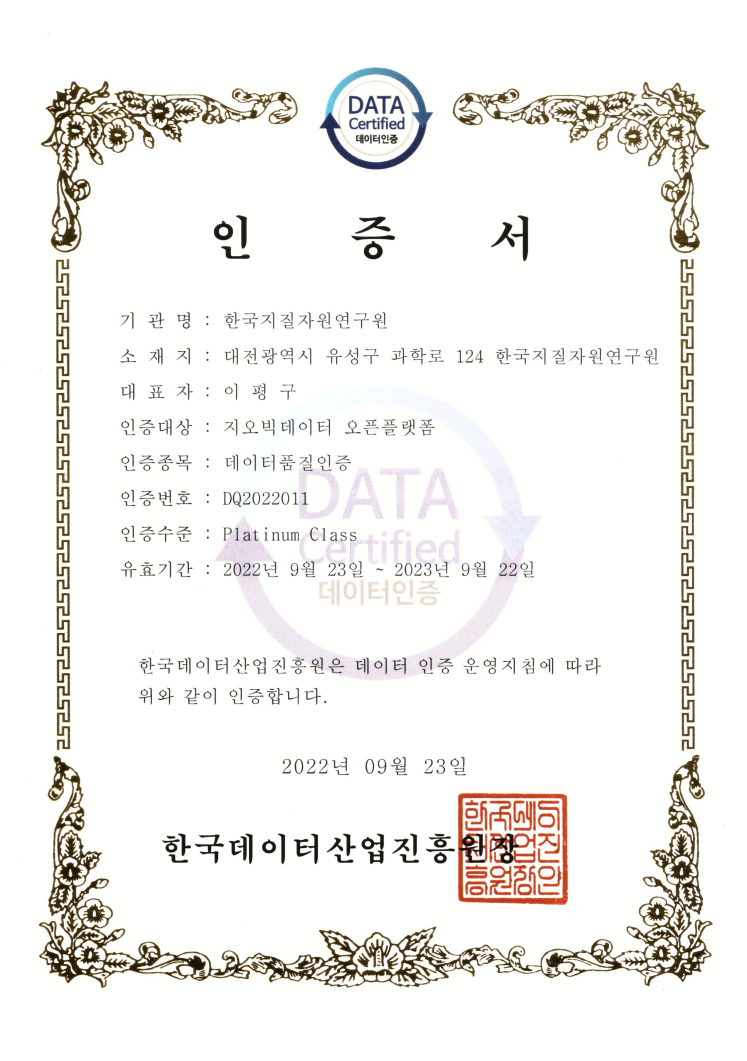Data Quality Certification (DQC-V)

| Data type | KIGAM 보고서 |
|---|---|
| Title | 국내 점토원료광물의 자원화 연구 |
| Author | 장영남 |
| Language | KOR |
| Call Number | KR-98-[B]-17-1998-R |
| Publication Information | 科學技術處, 1998 |
| Abstract | 1) 합성 카오리나이트 기술개발 : ① 시약급 Al(OH)₃3와 SiO₂를 열수반응시켜 판상 카오리나이트 합성기술개발 ② 국내산 엽납석질 납석을 출발물질로 하여 카오리나이트 합성실험에서 엽납석을 활성화 시킨 후 알루미나 성분을 Incorporation 시켜서 200℃/10 atm, pH 0.5의 실험조건에서 성공적으로 합성 ③ 합성된 캐올리나이트가 판상으로서 제지코팅이나 IC 기판용 소재로 사용될 수 있도록 고순도를 유지하는지를 확인하지 못하였으나 3차년도에 실험을 개선하여 국내산 납석의 용도 다양화와 부가가치 제고가 가능할 것으로 판단. 2) 화강암 풍화물 자원화 ① 충남, 전남북 일대에 분포하는 화강암체는 지질 및 암석학적 특성을 기준으로 홍성-아산 화강암체, 논산-익산-김제-고창 화강암체 및 나원-순창 화강암체로 구분하여 조사 ② 고령토 부존가능 지역은 전북 익산시 용동면 일부지역, 김제시 백구면, 용지면 일부지역, 순창군 팔덕면 일부지역, 곡성군 옥과면 일부지역 및 충남 아산시 신창면 일부지역 ③ 비교적 고령토화가 잘 된 화강암풍화물(대표시료) 55개에 대한 입도분리 결과 고령토대 세골재비가 평균 23% 대 77%의 함유비를 나타내고 고령토의 함유량이 많음 ④ 화강암 풍화물에서 분리된 고령토 시료의 X선회절 분석 결과 광물조성은 고령토 광물인 카오린 및 불순광물인 석영, 장석, 운모로 구성됨 ⑤ 화강암 풍화물에서 입도분리 작업 결과 전체적으로 약 23%의 고령토 함유비를 가지며 분석 결과 철분함량은 3% 이상으로 대부분 높은 편이나 입도 분리된 고령토 원광상태로 내화용 벽돌, 타일소지용, 및 황토방원료로 사용 가능하며 철분을 제거할 경우 고급도자기 제지요, 충진제 원료 등으로 사용가능. 부산물로 산출되는 세골재는 건축자재로 활용가능할 것으로 보인다. 3) 점토질암의 산업소재 자원화 : ① 점토질암이 부존된 지역은 전남 화순군 남면 일대로서 점토질암은 석탄기-페름기의 변성퇴적암내의 천운산층에 협재 ② 천운산층 내에 협재된 점토질암은 주향이 N18-55。 E로서 천운산층의 층리방향과 유사하며 두께는 2-8m에 달하는 것이 보통이다 ③ 벽송리지역 일대의 점토질암은 N35-55。 E의 주향과 15-35。 N W의 경사를 보이며 조립질 사암내 2-9m의 폭으로 3-4개조가 협재되어 습곡구조에 의해 반복 발달하고 있으며 이들의 매장량은 494,600 ton이다 ④ 점토질암은 주로 캐올리나이트, 홍주석, 엽납석, 백운모, 틀로리토이드 등으로 구성되어 있으며 부성분광물로는 석영, 탄질물, 루타일, 전기석, 다이아스포어, 이산화철 등을 들 수 있다. 유용광물로는 고알루미나 성분을 함유한 캐올리나이트, 엽납석, 홍주석, 딕카이트 등을 들 수 있으며 불용광물은 함철광물인 클로리토이드, 이산화철 및 탄질물이 산출된다 ⑤ 점토질암의 화학성분 시료 18개 가운데 Al₂O₃의 성분함량이 40% 이상되는 것이 6개, 35% 이상되는 것이 8개이다 1) Synthesis of Kaolinite form the Pyrophyllite by the Hydrothermal Reaction : Synthetic experiments were performed to find out the formation mechanism of kaolinte and iptimum conditions of transformation from pyrophyllite to kaolinite by the hydrothermal reaction. The starting materials of the reaction was the chemicals, Al(OH)₃, Al(Cl)₃, and HCo solution of pH 0.5-1.5 as the mineralizer. The temperature and pressure of the reaction was 200 C and 10-20 atm, respectively. The expected reaction runs as follows : Al₂Sl₄O10(OH)₂ +2Al³+ = 2Al₂Sl₂O5(OH)₄. Because the Al³+ ion is not actively incorporated into the pyrophyllite, even in prolonged reaction time to 10 days, the sample is previously heat-treated, together with NaOH. The gelized pyrophyllite is easily converted into kaolinite in acidic solution, at the temperature below 200 and about 10 atm. The synthetic reaction is promoted by adding Al(Cl)₃ as the mineralizer. Alumimum chloride is considered to supply pyrophyllite the alumimum ion during the conversion reaction and reprepare the acid solution condition by adding H+-component as the by-product. It is observed that the effect was significantly increased when 5Wt% natural kaolinite is added as the seed. The crystal sutructure and shape of these synthesized kaolinite was investigated by XRD and SEM.2) Research on the Weathered Granite in the Choongnam, Jeonnam, and Jeon-bug Provinces : Purposes of weathered granite research are in the assurance of kaolinite and accompanied fine aggregate resources, and their proper utilities must be studied. More than on third of total areas is occupied by granitic rocks in Korean peninsula. Target areas of 1998 are grouped into three in the viewpoint of distribution of granite outcrops, Hongseong-Asan-Yesan area, Nonsan-Igsan-Gochang-Younggwang area, and Namwon-Soochang-Gwangjoo area. Among them areas of Shinchang-myon, Asan-gun, Choongnam Province, Baeggoo-myon, Yongji-myon, Gimje-gun, and Paldeong-myon, Soochang-gun, Jeonbug Province, and Oggwa-myon, Gogseong-gun, Jeonnam Province, show rather well kaolinized leucoratic granites. Among 238 samples caught in the abouve areas, 55 samples were chosen for size separation by wet sieving method, and were analyzed for chemical compositions. Fine fractions under 230 microns contain 23.2%(wt) in average, and the others are fine aggregates over than 230 microns. And Fe₂O₃ contents geneally show over 3% and refractoriness values (S.K) merely represent about 18+, as a result they belong to rather low grade kaolinite. Mineral compositions identified by CRD (X-ray diffraction) technique shows that kaolinite, micas, and 14Å minerals (chlorites and vermiculites) are major clay minerals. And quartz and feldspars are main silicate minerals. Kaolinite found in this study could be used as a raw material in ceramics, structural tiles, and red brick manufactures, and fine aggregates recovered as a by-product might be used for construction. If iron oxide materials contained in the fine fractions are effectively eliminated, it would be possible to use as high grade fillers and several kind of ceramic raw materials. 3) Appled mineralogical study of the claystones in the Hwasoon area : Texture and mineral composition of claystones of the Cheonunsan Formation in the Hwasoon area have been studied using optical microscope. Optical microscopic analyses show that the original sedimentary claystones rich in aluminium were subjected to metamorphism by which they changed to the metamorphosed claystone sonsisting mainly of chloritoid, quartz, andalusite and illite. Later intensive hydrothermal kaolinization of this metamorphosed claystone resulted in the formation fo high-aluminous claystones rich in kaolinite exhibiting various complicated replacement textures. The probable high alumina claystone reserves are 496,600 M/T in the Byeogsongri of the Hwasoon area |
| Page | vii, 119 p. |
| Keyword | 합성, 합성카오리나이트, 카오리나이트, 화강풍화물, 점토질암, 점토, 점토원료광물, 카올리나이트, 납석, 화강암, 풍화물 |
|
For data where report download is not enabled,please contact the KIGAM Library. |
|
Comments